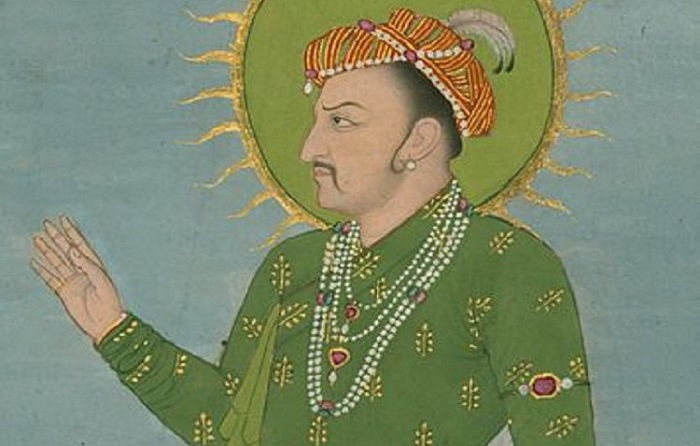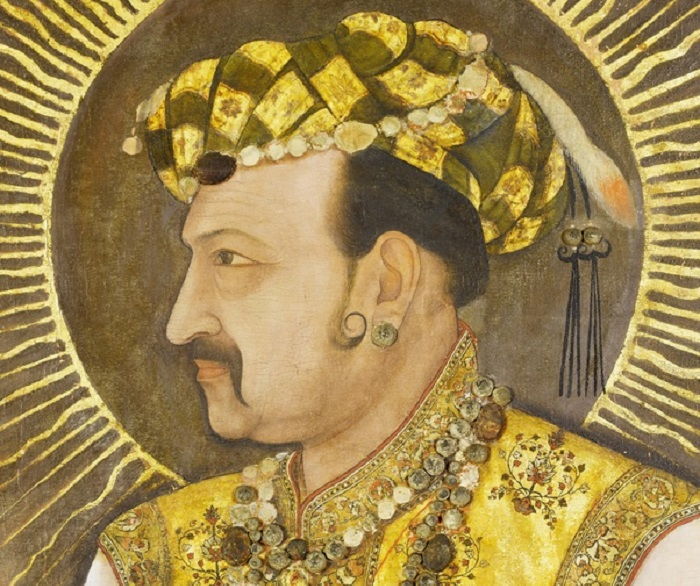Facts
Original Name: Mirza Nur-ud-din Beig Mohammad Khan Salim
Birth: 31 August 1569
Place of Birth: Fatehpur Sikri, Mughal Empire
Coronation: 24 November 1605
Reign: 3 November 1605 – 28 October 1627
Death: 28 October 1627
Place of Death: Rajauri, Kashmir, Mughal Empire
Father: Akbar the Great
Mother: Mariam-uz-Zamani
Consort: Nur Jahan
Predecessor: Akbar
Successor: Shahryar Mirza, Shah Jahan
Wives: Nur Jahan, Shah Begum, Jagat Gosain, Sahib Jamal, Malika Jahan, Nur-un-Nisa Begum, Khas Mahal, Karamsi, Saliha Banu Begum
Children: Khusrau Mirza, Parviz Mirza, Khurram Mirza, Shahryar Mirza, Jahandar Mirza, Sultan-un-Nissa Begum, Daulat-un-Nissa Begum, Bahar Banu Begum, Begum Sultan Begum, Iffat Banu Begum
Jahangir was the fourth Mughal emperor and one of the most prominent rulers of the great empire. He ruled from 1605 until his death in 1627. He had a bitter relationship with his father and tried to revolt against Akbar several times, but the father and son later reconciled. Apart from his military campaigns, Jahangir also gave importance to arts, especially painting. Jehangir’s relationship with the Mughal courtesan, Anarkali, has been the subject of several films and literature pieces. He also ordered the execution of the fifth Sikh Guru, Guru Arjan Dev. By 1627, Jahangir’s health had deteriorated, and he died on October 28, 1627. His mausoleum, Tomb of Jahangir, located at Shahdara, is a major tourist attraction in present-day Lahore.

Image Credit : https://www.rvcj.com/facts-mughal-rulers-every-indian-must-know/jahangir/
Childhood & Early Life
Jahangir was born Nur-ud-din Muhammad Salim on August 31, 1569, at Fatehpur Sikri, Mughal Empire, in present-day Uttar Pradesh. Since Mughal Emperor Akbar’s previous children had died at various stages of infancy, Akbar had become increasingly worried and hence approached a few holy men to bless him and his wife Mariam-uz-Zamani (Jodha Bai) with a son. The royal couple was subsequently blessed with a son, whom they named Salim. He was named after a Sufi saint, Salim Chishti, who had earlier blessed Akbar.
As a young prince, Jahangir had rebelled against his father for various reasons, including the throne. Upon Akbar’s death on October 27, 1605, Jahangir ascended the throne forcefully, which did not go down well with many within the royal court. In fact, his own son, Khusrau Mirza, had revolted against him. Mirza had claimed that he was the rightful heir to the Mughal throne as per his grandfather Akbar’s wish. But when his father crowned himself the emperor, Mirza became rebellious and chose to fight against Jahangir.
Jahangir’s forces were successful in defeating Khusrau Mirza and his supporters in the battle of Bhairowal. Khusrau and his supporters were caught by Jahangir’s men and brought to Delhi. Despite being the emperor’s son, Khusrau Mirza was partially blinded for his act of treason. He was later killed on January 26, 1622, at the orders of his brother, Prince Khurram (Shah Jahan), who was Jahangir’s favorite.
Marriages
Jahangir had a total of 20 wives, including his favorite wife and consort, Nur Jahan. Many of his weddings were conducted for political reasons, while others were personal. In 1585, when Jahangir was barely 16 years old, he was engaged to the Rajput princess of Amer, Man Bai. Man Bai was Jahangir’s cousin as his mother, Jodha Bai, was related to Man Bai’s father. The wedding took place on February 13, 1585, post which the couple was blessed with two children. At the time of their son Khusrau Mirza’s birth, Jahangir changed Man Bai’s name to Shah Begum (royal lady).
After his first wedding, Jahangir married few other women in quick succession. On June 26, 1586, Jahangir married Udai Singh’s daughter, Jagat Gosain. The wedding was a political event as Udai Singh had promised to give his daughter’s hand in marriage to Jahangir after accepting Akbar’s suzerainty. Jagat Gosain, who was known for her beauty, intelligence, courage, and wit, became Jahangir’s favorite wife soon after their wedding. The couple was blessed with three children, including two daughters, who had died in infancy. Their only son, Khurram, who would later ascend the throne as Emperor Shah Jahan, became Jahangir’s favorite son.

Image Credit : https://www.wonders-of-the-world.net/Taj-Mahal/Jahangir.php
After marrying the daughter of Raja Rai Singh of Bikaner on July 7, 1586, he went on to marry Malika Shikar Begum, the princess of Kashghar in the same month. In October 1586, he married Sahib Jamal. Sahib Jamal gave birth to two children – a son named Sultan Parviz Mirza and a daughter who died young. In 1587, he married the Rajput princess of Jaisalmer, Malika Jahan.
In October 1590, he married Mirza Sanjar Hazara’s daughter, Zohra Begum. The following year, he married Karamnasi Begum, the princess of Mertia. He then married Kanwal Rani on January 11, 1592, and then followed it up with another marriage with the daughter of Husain Chak of Kashmir on October 1592. By 1596, Jahangir had married three other women and had fallen in love with Khas Mahal Begum. On June 28, 1596, Jahangir married Khas Mahal, who became the empress when Jahangir ascended the throne.
After marrying Saliha Banu Begum in 1608, Jahangir married the daughter of Prince Jagat Singh, Koka Kumari Begum on June 17, 1608. After marrying a few more women in subsequent years, he married Mehr-un-Nisaa (Nur Jahan), who became his twentieth and last wife. Nur Jahan went on to become Jahangir’s favorite wife, so much so that she had control over the entire empire during her reign as the emperor’s royal consort.
Marriage with Nur Jahan & Her Influence
Mehr-un-Nisaa, who later came to be known as Nur Jahan, was married to Sher Afgan Khan. According to certain texts, Jahangir was attracted to Mehr-un-Nisaa even when she was already married to Sher Afgan Khan. Since she was a beautiful, strong, witty, well-educated, and a charismatic woman, Jahangir had fallen head over heels in love with her. Soon after Sher Afgan’s death, Jahangir summoned Mehr-un-Nissa to Agra. In 1611, four years after the death of Sher Afgan, Emperor Jahangir proposed to Mehr-un-Nissa during the festival of ‘Nowruz.’ Jahangir married her on May 25, 1611, and bestowed upon her the title ‘Nur Mahal.’ Five years later, she was honored with the title of ‘Nur Jahan,’ which translates to ‘Light of the World.’
After her wedding with Jahangir, Nur Jahan became his favorite wife and had his complete attention. As a result, she wielded influence over the administration of the Mughal Empire and was considered very powerful at the court. She had great influence on Jahangir and thereby had a direct influence on the affairs of the state. She was actively involved in political and military affairs and even held independent courts whenever required. Simply put, she became the power behind the Mughal throne during Jahangir’s reign. Nur Jahan also possessed great administrative skills and bravery, which she used to defend the Empire’s borders at the time of Jahangir’s absence. She was also known for her ability to lead armed forces whenever required.

Image Credit : https://www.thefamouspeople.com/profiles/jahangir-6991.php
Conquests
While most north Indian territories were conquered by Jahangir’s father, Akbar, some regions including Mewar in Rajasthan were left unconquered by Akbar. Also, Akbar had failed to capture regions in South India. After becoming the emperor, Jahangir’s primary goal was to capture areas unconquered by Akbar. Hence, Jahangir’s first military campaign was against Rana Amar Singh of Mewar. Almost immediately after becoming the emperor, Jahangir sent an expedition headed by Parwez to conquer Mewar. However, the contingent was recalled when his son, Khusrau Mirza, rose in revolt against him. After defeating Khusrau Mirza, Jahangir sent another expedition to Mewar. This time around, he was successful in making Rana Amar Singh of Mewar surrender before him, which led to a peace treaty between Rana and Jahangir. The peace treaty, which was signed in 1615, was favorable to the Mughals.
After gaining control over Mewar, Jahangir turned his attention towards South India. While trying to conquer Ahmednagar, Jahangir was confronted by Malik Ambar, the Wazir of Ahmednagar. Despite his best efforts, Jahangir was not able to gain complete control over regions like Ahmednagar, Golconda, and Bijapur. However, the king of Bijapur acted as a mediator between the ruler of Ahmednagar and the Mughals. Subsequently the ruler of Bijapur succeeded in arranging a peace treaty between Ahmednagar and the Mughal Empire, post which a few forts and the territory of Balaghat were given to the Mughals. But Malik Ambar did not abide by the rules of the treaty and besieged the Ahmednagar fort in 1620. In 1621, another peace treaty was signed between Malik Ambar and the Mughals, post which the ruler of Ahmednagar surrendered the territories he had earlier captured from the Mughals. The Mughals were also awarded monetary compensation as a result of the treaty. However, Jahangir could never gain complete control over South India, which makes the treaty of Mewar his best military event.
Death
By 1627, Jahangir’s heath had deteriorated, which prompted him to visit places like Kashmir and Kabul with the hope of restoring his health. After visiting Kashmir, the emperor decided to return to Lahore as his health worsened due to severe cold. While returning to Lahore along with his contingent, Jahangir passed away on October 28, 1627, at Sarai Saadabad in Bhimber. After removing his entrails, his body was temporarily buried in Baghsar Fort and was later moved to Lahore, where it was buried in Shahdara Bagh. His mausoleum, Tomb of Jahangir, which is located at Shahdara, is a major tourist attraction in present-day Lahore.
Religious Views
Though he was not a religious person, a statement which is often confused by the westerners, who say that he was an atheist, Jahangir observed the principles of Islam as he had faith in God. When it came to handling his subjects, Jahangir did not grant special and biased powers to Muslims, nor did he burden the Hindus with special taxes. However, he is said to have tortured many Hindus for marrying Muslim girls in Kashmir. Interestingly, the emperor himself married many Hindu women, which left them with no other option but to convert to Islam.

Image Credit : https://www.quora.com/Who-was-the-son-of-Jahangir
Jahangir’s hatred towards the fifth Sikh Guru, Guru Arjan Dev, paved the way for tension between the Sikhs and the Mughals for a very long time. Though seen as a political move by many, Jahangir’s decision to execute Guru Arjan Dev convinced people that Jahangir hated Hindus and the Sikhs. In another instance, Jahangir is said to have ordered the removal of a Varaha statue while visiting a Hindu temple. These incidents are viewed as evidences of Jahangir’s dislike towards other religions, especially Hinduism.
Jahangir was attracted by Christian themes, which played a major role in him allowing the British to conduct trade in his territory. In fact, many texts suggest that Jahangir had pictures of Christ in his prayer room. It is also said that the Mughal emperor had pictures of angels and demons, with demons portrayed as ugly creatures. Jahangir’s liking towards Christianity was so great that there were rumors that suggested he had converted to Christianity. However, these rumors were rubbished by the English ambassador, Thomas Roe, who could not figure out Jahangir’s intention towards other religions.
Art During Jahangir’s Reign
Apart from strengthening his military prowess, Jahangir also gave importance to arts, especially painting. During his reign, the emperor commissioned many paintings, including several portraits of himself. The Mughal painting flourished under Jahangir’s reign, which provided opportunity to many artists. He also carefully preserved paintings, which were commissioned by his father, Akbar. Jahangir was greatly influenced by European art and architecture. According to English ambassador, Thomas Roe, the emperor would have his court painters reproduce a European miniature and then would challenge Thomas Roe to pick the original work. Whenever Roe failed to pick the original work, Jahangir would derive immense satisfaction and pride from it. The ‘British Museum’ in London has a collection of 74 paintings that were commissioned by Jahangir. Like many other Mughal emperors, Jahangir too, encouraged art and welcomed artists from across the world to exhibit their talent in the Mughal court.


